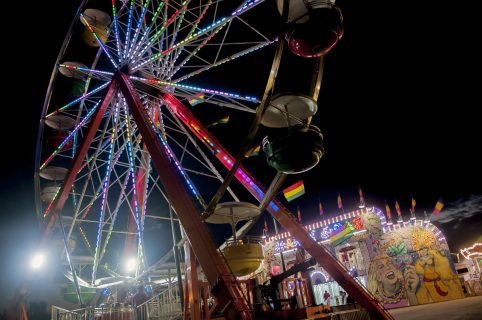Tourism and hospitality is multi-billion dollar industry in Kentucky
Published 5:00 am Sunday, April 16, 2017

- Looking at the planes at the Aviation Heritage Park situated at Basil Griffin Park is free. It is one activity, however, that can be added to the itinerary for visitors.
Taxes paid by tourists lessen Warren Countians’ state and local tax burden by nearly $1,000 per household, according to one official.
Tourism was responsible for $13.7 billion to Kentucky’s economy in 2015, the latest numbers available from the state’s Tourism, Arts & Heritage Cabinet. New numbers will be released next month. The industry generated more than $1.43 billion in tax revenues in 2015.
Trending
“It is a huge driver of the economy in Kentucky,” said Hank Phillips, president and chief executive officer of the Kentucky Travel Industry Association, a trade organization that represents all segments of Kentucky’s tourism industry. “It is the third-largest industry in the state, and people don’t realize how much of an economic contribution that tourism makes to the state.
“For every dollar that the state invests in advertising Kentucky, their research shows that $150 comes back in visitor expenditures. For every dollar invested, there are $16 in local and state tax revenues that come back from that investment. The return on tourism investment is huge both in terms of money coming into the economy and much-needed local and state tax revenue,” Phillips said.
While all nine tourism regions in the state generated revenue increases year over year from 2014 to 2015, the Cave, Lakes & Corvettes Region – Allen, Barren, Butler, Edmonson, Hart, Logan, Metcalfe, Monroe, Simpson and Warren counties – showed the second-largest increase of 6.9 percent from more than $621 million in 2014 total travel expenditures to more than $664 million in 2015, according to the Economic Impact of Kentucky’s Travel and Tourism Industry report released last spring. A new report will be released next month, and industry experts are optimistic for another year of gains.
Caves, Lakes & Corvettes
“I don’t have any direct knowledge or any way of predicting an increase, but I will be surprised if there is a not at least a moderate increase,” Phillips said. “I can tie that to a couple of interesting things. If you take the name of that region, the Caves, Lakes & Corvettes Region, the name encompasses the reason. Last year was the 100th anniversary of the national parks. There was a big push to commemorate that historic anniversary.
“The other thing is in terms of lakes, outdoor recreation especially in Kentucky has always been popular, but there has been a growth in popularity.
Trending
“The Corvette museum and the assembly plant, today people travel to have authentic experiences. There is nothing more authentic then the Corvette museum. To me, if we put together all the assets of that region, it points to another good year. I’m optimistic,” Phillips said.
Mammoth Cave National Park visitation increased 8 percent from 2015 to 2016.
Cave visitation rose 10 percent in 2016 from 2015 with 468,784 cave visitors in 2016. That’s 42,000 more visitors than in 2015.
The park is currently working to get a Dark Sky Park designation from the International Dark-Sky Association to attract tourists interested in getting away from the light pollution of the city to stargaze.
“Mammoth Cave is this special area that is very dark at night. We are fairly rural. We don’t have a lot of light pollution,” park Superintendent Sarah Craighead told the Daily News in January. “You have the opportunity to see the stars, to see the Milky Way. We have some pretty good night skies around Mammoth Cave.”
The Corvette museum saw a significant spike in visitors in 2014 after a sinkhole opened up in February 2014 inside the museum, swallowing eight prized Corvettes and generating international headlines.
In 2014, publicity generated by the sinkhole combined with the museum’s 20th anniversary celebration and the opening of the NCM Motorsports Park drew 251,258 people to the museum. The following year, the number dropped to 220,665. Last year, museum attendance grew to 228,363 people, according to Katie Frassinelli, museum spokeswoman.
This year, to commemorate the third anniversary of the sinkhole, the museum is restoring a 1962 Corvette. Visitors will be able to watch the restoration as it takes place. Visitors can also still peek down into part of the sinkhole and the museum continues to sell jars of sinkhole dirt and rock. The museum has sold $40,000 worth of jars of sinkhole dirt, Frassinelli said.
The museum employs more than 100 people.
By mid-April at the NCM Motorsports Park, a new go-kart track is expected to draw visitors from around the region. The activity is open to anyone who meets the height requirements.
“They’re fast,” Frassinelli said. The go-karts can hit speeds of over 45 mph.
“It’s something anyone can show up and pay to take a ride,” she said. “It’s something the whole family can do.”
The attraction is also fun for corporate and business team building and corporate hospitality, Frassinelli said.
Area hotels see
high occupancy
All of the attractions and Bowling Green’s event-rich calendar have been keeping hotels brimming with guests.
“I think the occupancy is pretty stable throughout the branded hotels,” said Drue Eberhardt, a board member of the Bowling Green Area Lodging Association, and the general manager of Holiday Inn Express.
Any occupancy rate of 85 percent or higher is considered successful in the industry, Eberhardt said.
“We surpass that,” he said.
From car shows to band competitions, Western Kentucky University and high school graduations in addition to events at Beech Bend and corporate visitors, it is not unusual for Bowling Green hotels to have citywide sellouts, he said.
“People come up to see Mammoth Cave and they stay in Bowling Green. Companies in town provide steady business throughout the week. A lot of people come in for Beech Bend. There’s a lot of corporate visitors. That brings in more business travelers,” Eberhardt said.
“Every year there seems to be a new hotel popping up somewhere,” he said. “Even with that, the market is still stable.”
The tourism and hospitality industry is thriving here for people who want to work in the field, he said.
“For me, I started out working front desk while I was in college. I did some event planning and worked at Hilton Garden Inn for a couple of years, then I came to this property. After about two years, I moved up to the general manager of the Holiday Inn Express. I’m 27 now. In a matter of five or six years, I’ve had a lot of growth opportunities that in my opinion the industry can offer,” he said. “It’s definitely something you have to work your way up on. But the opportunities are there. If you are a good worker, you can get to where you want to be.”
Jane Simmons, an instructor and adviser for the hotel, restaurant and tourism management majors at WKU, said the job market for WKU students entering the hospitality field is healthy.
“There are jobs available, not just in the hotel business but in the tourism business with events, different venues,” Simmons said. “It is a good, healthy market, and they can find jobs. I have some that will be graduating in May, and they are already interviewing for jobs.”
Spending expected to grow
Laura Brooks, communications director for the Kentucky tourism cabinet, said she expects to see growth in tourism spending year over year from 2015 to 2016 in the upcoming May report.
“It’s grown each year, and we would anticipate the same trend,” Brooks said.
Vicki Fitch, executive director of the Bowling Green Area Convention and Visitors Bureau, is expecting to see growth locally.
“I expect we would likely show gains,” Fitch said. “I’m able to track a little bit with the hotel sector. Those have positive numbers year over year from what I’m seeing. That’s the most concrete area. The attractions have done well. I would be surprised if we didn’t see that we had growth.”
The growth not only helps the tax base, it also creates jobs.
“It means a lot of jobs all the way from the direct jobs like tour guides, housekeepers and front desk clerks to much higher paying jobs of manager and executive directors and people running the businesses.
“Shopping is such an important part of a tourist experience. It is one of the areas that a visitor spends the most amount of money when they are in our area. Visitors are leaving their money here in our community, not just at the hotels and attractions. It’s a lot deeper than that.
“Then there is a residual effect, the carryover effect where for instance a person who owns a shop, the money that the visitor brings in is helping their quality of life in Bowling Green where they are able to buy cars, furniture” and other items.
“If tourism did not exist, each household in Warren County would have paid $963 more in state and local taxes in 2015 to replace the taxes generated by tourist spending,” Fitch said.
“For every dollar that the state invests in advertising Kentucky, their research shows that $150 comes back in visitor expenditures. For every dollar invested, there are $16 in local and state tax revenues that come back from that investment. The return on tourism investment is huge both in terms of money coming into the economy and much needed local and state tax revenue,” said Hank Phillips president and chief executive officer of the Kentucky Travel Industry Association.






